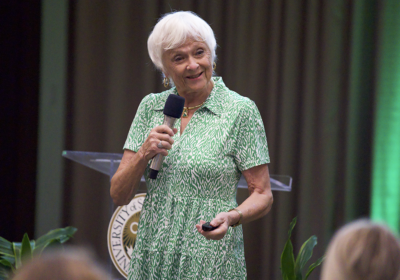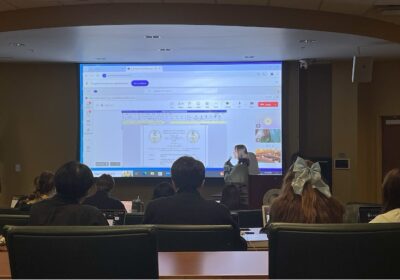USF researchers investigate oil spill
When the Deepwater Horizon petroleum well, owned by oil company BP, exploded April 20, hundreds of gallons of oil began spewing into the Gulf of Mexico. And it hasn’t stopped. Now, USF has developed teams of researchers to help track the effects of the oil on the marine ecosystem.
One such team, comprised of USF biological oceanographers Ernst Peebles, David Jones, Ralph Kitzmiller, Holly Rolls, Kara Radabaugh, Drew Remsen and scientists from the Florida Fish and Wildlife Research Center, set out for the Gulf of Mexico on May 5 to investigate the extent of the damage the spill has caused to microscopic marine life.
The team spent a little more than a week gathering water samples from areas in the gulf that have not yet been affected by the spill to provide samples to compare to the contaminated water harvested from their 24–hour stay in the affected area.
Peebles said the team used an underwater imaging device called a SIPPER to capture images of objects without disturbing them in their natural state.
The device then translates those images into data, making it easier for the team to analyze whether the oil has damaged the microscopic zooplankton and fish larvae central to the gulf’s food chain, Peebles said.
“The plan is to deploy the SIPPER three times and capture detailed images of the tiny droplets of oil coming from the ruptured well,” Peebles said.
The team, which will return to the College of Marine Science at the University’s St. Petersburg campus today at 9 a.m., is being transported in the gulf by USF’s R/V Weatherbird II, a research vessel operated by the Florida Institute of Oceanography (FIO) that is made available to all Florida state universities.
Communications and Marketing manager Vickie Chachere said the data and samples the team collects will be turned over to the National Oceanic and Atmospheric Administration (NOAA) because of the “delicate nature” surrounding
the cause of the oil spill and the legal repercussions that could follow for those responsible for the spill.
“It will take the team months to analyze all of the data,” Chachere said. “And, it will all be something that will be presented in a formal report.”
John Ogden, former director of FIO, said that, depending on the currents in the gulf, the spill could be a “big event” for Florida.
“The question is, ‘What should we be doing as a nation to wean ourselves off of oil?'” he said. “Then, develop the technologies to do so.”
Some of those technologies may come from the USF School of Global Sustainability, said itsDirector Christian Wells, something many students have taken an interest in because of the spill.
“I hope that students will be encouraged to take action to examine their own impact on the environment,” he said. “And also, to participate in existing clean energy dialogues at the University.”
One such opportunity rests in he College of Engineering’s Clean Energy Research Center, which aims to develop, evaluate and promote the commercialization of renewable energy solutions. Among their accomplishments is the nation’s first 20,000-watt solar/electric charging station for electric vehicles – an advancement that could lead to a significant decrease in oil consumption.
The College of Marine Science has also taken part in the effort, creating the Ocean Circulation Group to track the spread of the oil slick through satellite imaging.
The team, which is composed of both optical and physical oceanographers, is led by physical oceanographer Robert Weisberg and has developed a series of models that have followed and predicted the spread of the oil through the northern gulf.
According to a release, Chuanmin Hu, an optical oceanographer in the group, said the team is also monitoring the spill’s movement toward the Loop Current, which could send the contaminated water past the Florida Keys and up the Atlantic coast – avoiding most of the state
Robert Buzzeo, a graduate student studying molecular biology, said if this happens it could be good news for Florida, which relies heavily on tourism to sustain the economy.
“An oil spill could be something that causes travelers to cancel their trips,” he said.
In the release, Hu estimated the size of the oil slick to be 14 times that of Tampa Bay. According to the Coast Guard, an estimated 5,000 barrels of oil have been leaking from the well per day. There are 42 gallons in a barrel.
Although sea turtles and dolphins have been found dead on the shores of neighboring gulf states, Florida officials said the long-term effects of the spill on wildlife are not yet clear.
Whatever the outcome may be, Buzzeo said the University’s efforts are a step in the right direction.
“It’s definitely encouraging to see that the University may have a role to play in correcting the situation,” he said.







